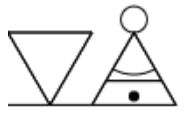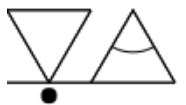Ditema tsa Dinoko
Ditema tsa Dinoko (SeSotho: "Ditema syllabary"), also known by its Zulu name, Isibheqe Sohlamvu, and various other related names in different languages,[1][2] is a contemporary writing system (specifically, a featural syllabary) associated with litema, that is used to write Sesotho (and all other Southern Bantu languages).[3]
A subset of Ditema, sintu, is used to represent Nguni languages consistently under one orthography.[4] This includes Tekela languages, which, with the exception of Swati, are unstandardised in the Latin alphabet. For example, it contains a specific grapheme indicating vowel nasality.
Description
The script is a syllabary, as each freestanding symbol represents a syllable. When the syllable being represented is not a syllabic consonant, these symbols are formed from a grapheme, a triangle or triangle with one side removed, representing the nucleus of the syllable, and attached graphemes that represent the onset of the syllable or its mode or articulation.[5]
Examples
| English | down/below | |
|---|---|---|
| Zunda | phansi |
 pʰaːntsʼi |
| Tekela | phãsi |
 pʰãːsi |
References
- ↑ "IsiBheqe". isibheqe.org. 23 August 2015. Retrieved 16 September 2015.
- ↑ "Isibheqe Sohlamvu: An Indigenous Writing System for Southern Bantu Languages" (PDF). linguistics.org.za. 22 June 2015. Retrieved 16 September 2015.
- ↑ "Isibheqe cabinets". Design Miami. Retrieved 2015-11-23.
- ↑ isibheqe.org (2015). "Isibheqe Sohlamvu/Ditema tsa Dinoko". isibheqe.org.
- ↑ "Ingcazo". isibheqe.org. Retrieved 2016-09-11.